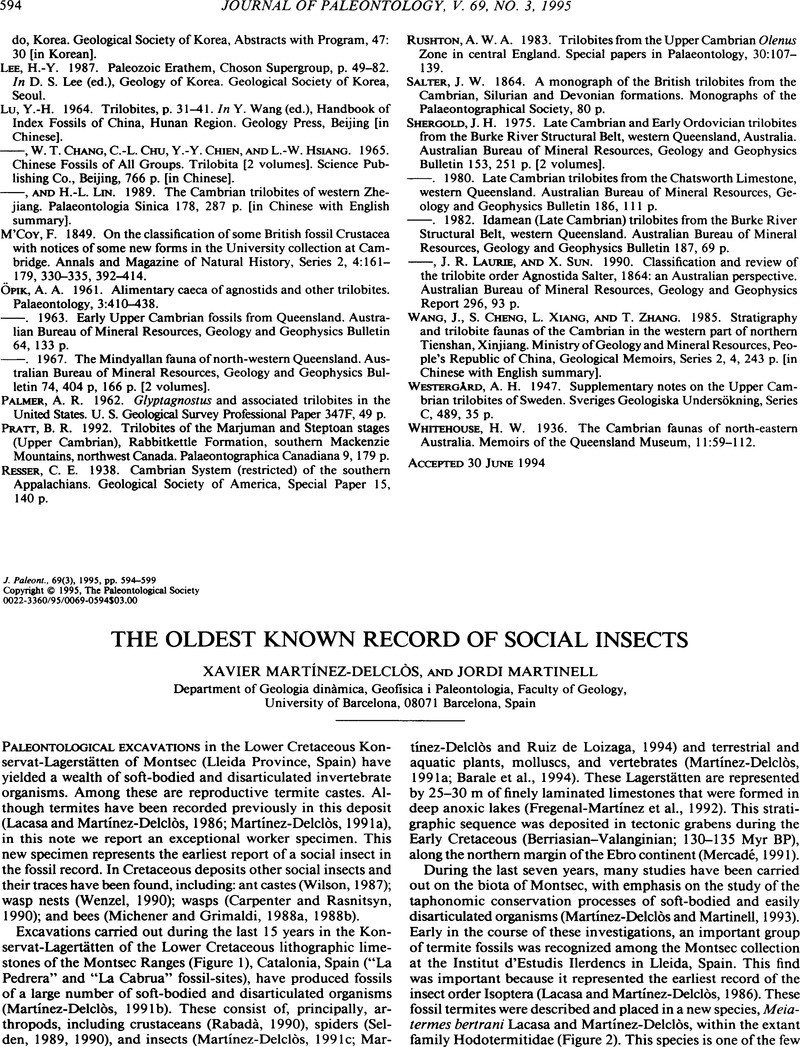Crossref Citations
This article has been cited by the following publications. This list is generated based on data provided by Crossref.
McShea, Daniel W.
1996.
PERSPECTIVE METAZOAN COMPLEXITY AND EVOLUTION: IS THERE A TREND?.
Evolution,
Vol. 50,
Issue. 2,
p.
477.
Grimaldi, David
and
Agosti, Donat
2000.
A formicine in New Jersey Cretaceous amber (Hymenoptera: Formicidae) and early evolution of the ants.
Proceedings of the National Academy of Sciences,
Vol. 97,
Issue. 25,
p.
13678.
Thorne, Barbara L.
Grimaldi, David A.
and
Krishna, Kumar
2000.
Termites: Evolution, Sociality, Symbioses, Ecology.
p.
77.
Hasiotis, Stephen T
2003.
Complex ichnofossils of solitary and social soil organisms: understanding their evolution and roles in terrestrial paleoecosystems.
Palaeogeography, Palaeoclimatology, Palaeoecology,
Vol. 192,
Issue. 1-4,
p.
259.
Martı́nez-Delclòs, Xavier
Briggs, Derek E.G
and
Peñalver, Enrique
2004.
Taphonomy of insects in carbonates and amber.
Palaeogeography, Palaeoclimatology, Palaeoecology,
Vol. 203,
Issue. 1-2,
p.
19.
GENISE, J. F.
2005.
Comment--Advanced Early Jurassic Termite (Insecta: Isoptera) Nests: Evidence from the Clarens Formation in the Tuli Basin, Southern Africa (Bordy et al., 2004).
PALAIOS,
Vol. 20,
Issue. 3,
p.
303.
WAPPLER, TORSTEN
and
ENGEL, MICHAEL S.
2006.
A NEW RECORD OF MASTOTERMES FROM THE EOCENE OF GERMANY (ISOPTERA: MASTOTERMITIDAE).
Journal of Paleontology,
Vol. 80,
Issue. 2,
p.
380.
Duringer, Philippe
Schuster, Mathieu
Genise, Jorge F.
Mackaye, Hassan T.
Vignaud, Patrick
and
Brunet, Michel
2007.
New termite trace fossils: Galleries, nests and fungus combs from the Chad basin of Africa (Upper Miocene–Lower Pliocene).
Palaeogeography, Palaeoclimatology, Palaeoecology,
Vol. 251,
Issue. 3-4,
p.
323.
Hasiotis, Stephen T.
2008.
Reply to the Comments by Bromley et al. of the paper “Reconnaissance of the Upper Jurassic Morrison Formation ichnofossils, Rocky Mountain Region, USA: Paleoenvironmental, stratigraphic, and paleoclimatic significance of terrestrial and freshwater ichnocoenoses” by Stephen T. Hasiotis.
Sedimentary Geology,
Vol. 208,
Issue. 1-2,
p.
61.
Longrich, Nicholas R.
and
Currie, Philip J.
2009.
Albertonykus borealis, a new alvarezsaur (Dinosauria: Theropoda) from the Early Maastrichtian of Alberta, Canada: implications for the systematics and ecology of the Alvarezsauridae.
Cretaceous Research,
Vol. 30,
Issue. 1,
p.
239.
Colin, Jean-Paul
Néraudeau, Didier
Nel, André
and
Perrichot, Vincent
2011.
Termite coprolites (Insecta: Isoptera) from the Cretaceous of western France: A palaeoecological insight.
Revue de Micropaléontologie,
Vol. 54,
Issue. 3,
p.
129.
2012.
Evolution of Fossil Ecosystems.
p.
268.
Penney, David
Green, David I.
Titchener, Simon B.
Titchener, Barry G.
Brown, Terence A.
and
Preziosi, Richard F.
2012.
An Unusual Palaeobiocoenosis of Subfossil Spiders in Colombian Copal.
Arachnology,
Vol. 15,
Issue. 7,
p.
241.
Labandeira, Conrad C.
2014.
Amber.
The Paleontological Society Papers,
Vol. 20,
Issue. ,
p.
163.
Legendre, Frédéric
Nel, André
Svenson, Gavin J.
Robillard, Tony
Pellens, Roseli
Grandcolas, Philippe
and
Escriva, Hector
2015.
Phylogeny of Dictyoptera: Dating the Origin of Cockroaches, Praying Mantises and Termites with Molecular Data and Controlled Fossil Evidence.
PLOS ONE,
Vol. 10,
Issue. 7,
p.
e0130127.
Bourguignon, Thomas
Chisholm, Ryan A.
and
Evans, Theodore A.
2016.
The Termite Worker Phenotype Evolved as a Dispersal Strategy for Fertile Wingless Individuals before Eusociality.
The American Naturalist,
Vol. 187,
Issue. 3,
p.
372.
Engel, Michael S.
Barden, Phillip
Riccio, Mark L.
and
Grimaldi, David A.
2016.
Morphologically Specialized Termite Castes and Advanced Sociality in the Early Cretaceous.
Current Biology,
Vol. 26,
Issue. 4,
p.
522.
Peris, David
2020.
Coleoptera in amber from Cretaceous resiniferous forests.
Cretaceous Research,
Vol. 113,
Issue. ,
p.
104484.
Sánchez-García, Alba
Peñalver, Enrique
Delclòs, Xavier
and
Engel, Michael S.
2020.
Early Cretaceous termites in amber from northern Spain (Isoptera).
Cretaceous Research,
Vol. 110,
Issue. ,
p.
104385.
Zhao, Zhipeng
Yin, Xiangchu
Shih, Chungkun
Gao, Taiping
and
Ren, Dong
2020.
Termite colonies from mid-Cretaceous Myanmar demonstrate their early eusocial lifestyle in damp wood.
National Science Review,
Vol. 7,
Issue. 2,
p.
381.



